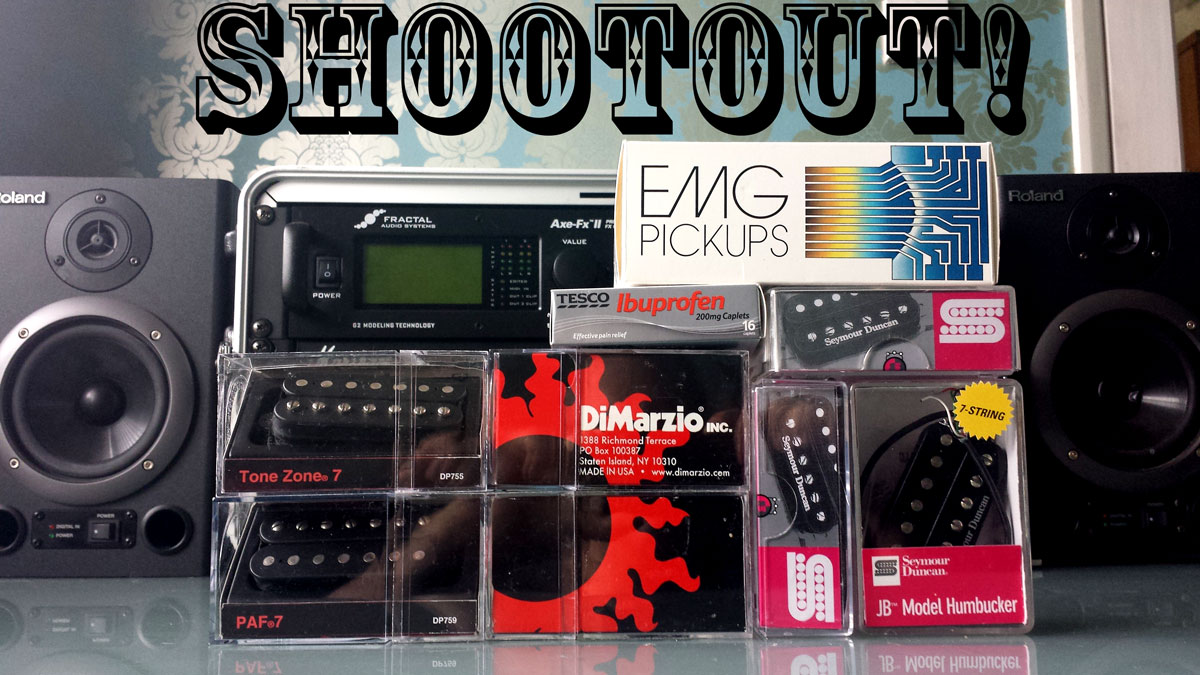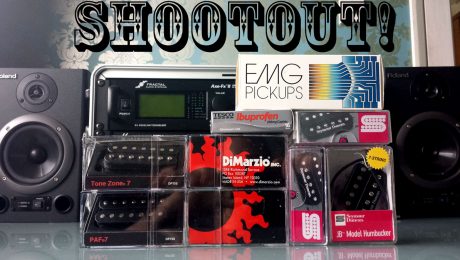7 String Pickup Test Comparison – My Analysis
Introduction

I’ve just completed testing 9 different pickups from Seymour Duncan, Dimarzio and EMG in either the same or very similar guitars. This blog is to share my thoughts on the results, because they weren’t what I was expecting…
Watch the videos here:
7 string clean bridge pickup comparison – EMG Dimarzio Seymour Duncan
7-string metal bridge pickup comparison – Dimarzio EMG Seymour Duncan – full mix
7-string metal bridge pickup comparison – Dimarzio EMG Seymour Duncan – no bass mix
Methodology
The methodology was to test them in a real world situation. Most of the work with my band Kill or Cure is currently studio-based, so for me it was natural to weight the test towards studio performance. I’d already recorded and released a track called Paradox. I’m pretty happy with the sound and the mix of that song. What I wanted to do with this pickup test was rerecord the guitar lines using the same Fractal Audio equipment, presets, mixing and mastering we used on the album and compare the results.
Background
I already had favourite pickups while recording the song last year, but since then I’d started preferring the ‘in the room’ sound from another pickup. So naturally I was expecting the new pickups to also improve on the original recording. When I listened back, that wasn’t the case. In fact, I slightly preferred the original stock pickup. More on that later, because that wasn’t the main surprise.
My results
The biggest surprise for me was how marginal the difference was between all the pickups in the final mixed metal recording. With my eyes shut, could I tell you which was which? Not from watching my own video back, no – not with any certainty anyway. And yet I could certainly distinguish most of the pickups from each other when playing them in the room. So does this mean this pickup test is flawed? No – because the final mix is the sound I was after. I didn’t want to change my presets purely to accentuate the differences.
However, if YOU want to do that, you can try for yourself with the supplied DI files. Reamp to your heart’s content and see what these pickups sound like through your setup.
Download the DI files here for metal riffing: https://dl.dropboxusercontent.com/u/1953576/Kill-or-Cure-Paradox-pickup-DI-files.zip
…and here for clean chordal work, where the recorded differences were more pronounced: https://dl.dropboxusercontent.com/u/1953576/7-string-bridge-pickup-clean-DI-files.zip
What this tells me is that the act of getting the tone to sit in the mix is making the pickups sounds more similar than just playing them in the room. So is it a universal rule that in any mix, all pickups will sound very similar? No. Let’s have a look at a couple of other pickup tests out there:
Other people’s pickup tests to check out
Firstly, this Keith Merrow one – despite the distorted tone, I can hear a lot of difference between the pickups and I have definite favourites. So Keith’s mix is bringing out more of the differences than the way we’ve chosen to mix. It’s a great gear demo and I encourage you to take a look: http://www.youtube.com/watch?v=mFO9phrDBig
Then there’s this test by Ola Englund: https://www.youtube.com/watch?v=U3YzI3sd2WA
Now the results here, even without other instruments getting in the way, sound very samey to me. But, again, that doesn’t make it a bad pickup demo. It shows me that a variety of equipment would get the job done to get the kind of sound Ola’s aiming for through his choice of amp or processor. But how does that help you? Well, Ola’s provided the DI files so you can reamp the raw sounds through your own equipment. (I tried this and found I could distinguish more easily through my own presets which pickups I preferred.)
What makes pickups sound similar?
So what does make pickups sound similar in my video, and in Ola’s?
1. The more gain and compression you apply, the less discernible differences in the output. (It’s certainly easier to hear differences in clean guitar tones – check out this test I did on clean tones: http://youtu.be/DvjEloEDt54)
2 – Once in the mix, those differences become even less – you have bass, drums, vocals all competing for frequencies, and it’s common to cut certain frequencies from the guitar to make room for those other instruments. If your various pickups sound distinct to you in the room but alike in the mix, the difference may well lie in the frequencies that the other instruments have taken.
3 – The quality of recording will affect how obvious the differences are. Youtube encoding and compression will take out some of the finer detail, as will converting to a low quality mp3, although I’ve done my best to upload at a high bitrate.
What makes pickups sound different?
Aside from the pickup construction itself and the proximity to the strings, it’s the guitar construction, materials and electrical components. I believe wood makes a difference (although this is a contested issue.) Whether or not you can hear it on the recording, I can tell you that my Crunch Lab pickup in Mahogany has a very different tone to in Basswood. I’ve tried to use one guitar for most of the pickup swaps, but I had a couple of similarly specced guitars already wired up with other pickups, so I’ve included them in the video as well, along with a note on the wood type and the weight. Electrics – what kind of volume pot have you got? Do you have a tone control in your setup? Do you have a treble bleed capacitor soldered into your setup? All these things between pickup and guitar lead can affect your final tone too.
In use
My favourite pickups vary depending on application – I’m not referring to whether it’s for a clean, a medium gain or an all out saturated distortion sound. I mean whether it’s for recording, playing live or practicing.
– Currently my favourite ‘in the room’ pickup is the Seymour Duncan Distortion. yet on my current presets it records a little bit trebley on demos I’m working on for our second album. But because I find its in the room sound very inspiring, i reach for that when I’m feeling creative and writing riffs.
– But for recording, my go-to seven string pickup is the stock Dimarzio New 7, designed specifically for a handful of Ibanez models like the RG7620 and the RG8527. It sits in the mix right where I want it. It’s tight, balanced and responsive, even though it’s not quite as much fun in the room.
There’s pickups in this test I didn’t particularly enjoy playing but sound awesome in the mix:
3 spring to mind:
– the PAF7 – it’s got a little less gain than some of the other pickups in the test. And for this type of song where i want a thick, consistent tone, my feeling while recording was maybe it needed a lttle more oomph. However, when I listen back, it sounds very full. Just as powerful as some of the others, but also clearer. That might be down to multitracking 4 guitars compensating for its lower gain, or it might be a result of the mix.
– JB7 – in the room I found the bass overpowering. But when I listen back in the mix, it’s nice and clear and dry, and sonically distinct from some of the other pickups.
– Crunch Lab 7 – I am a huge fan of the Crunch Lab 6 string I have in an alder guitar. But I wasn’t loving this 7 string version in the darker mahogany body. However, listening back, it’s pretty much in the ballpark of what I’m after. Fixed in the mix?
Stock pickups vs branded pickups
That brings me onto stock pickups vs big brand pickups Stock pickups get a lot of hate, some of it undeservedly so. Why is this? In some cases it’s because they’re made from cheaper materials or by less experienced manufacturers. But this is not always true. Take the ‘New 7’ found in many standard Ibanez models of the 2000s. This is a through and through bona-fide Dimarzio – it’s got their name on the back, it’s made in the same factory as the other Dimarzios – yet it gets a bad rep on the forums. Is this down to the tone or down to lack of obvious branding? It’s seen as an Ibanez stock pickup. Personally I love them. And think on this – stock pickups are chosen by the guitar product managers to complement that model and work with the woods and setup (as well as hit the right price point ). The picker might not have the same taste as you but it’s a good starting point to ensure a good match. I’m also a fan of the Ibanez F2 pickup that came on the 1990s S series guitars, because it’s the right pickup matched with the right guitar.
The importance of feel
An element you can’t capture in a video is response to touch. How sensitive and dynamic are the pickups? Do they respond to subtle changes in your playing style? You might not hear the difference in the final recording but if it makes you play better by feeling more connected with your tone, a pickup change can be worth it. Even if I decide not to record with a Seymour Duncan Distortion, the number of riffs it has given me from the sheer joy of playing it is priceless.
Your turn…
Have you ever downloaded someone else’s presets for some of your gear, whether you’ve got an effects unit, or a Line 6 Pod or some other digital modeler – and when you try the preset with your gear, it sounds terrible? That’s why I’ve made the DI files available – so you don’t have to live with my choice of sound. You can try reamping them through your own gear using settings you’re familiar with. You might also have settings that bring out the characteristic differences between pickups more than my preferred setup.
Download the metal riff DI files here: https://dl.dropboxusercontent.com/u/1953576/Kill-or-Cure-Paradox-pickup-DI-files.zip
Download the track ‘Paradox’ here: http://killorcure.bandcamp.com/track/paradox
Conclusion
If I was listening back in a blind test to my video, could I tell the difference in the mix? Probably not between all of them. I could probably distinguish between actives and passives. I might pick out the JB as it has a certain nasal tone on the low B. But maybe not the others. Does that bother me? Not much. It’s reassuring to know that out of all the pickups I tested, I’d be happy recording with any of these and I’d still be able to capture ‘my sound’. And at the end of the day that’s what we’re all aiming for. Will I ever swap pickups again? Undoubtedly, even if – in my distorted setup – the major difference is in the room rather than in my recorded sound.
- Published in Gear, Recording, Uncategorized

